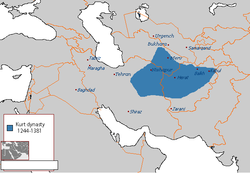Kurt Dynasty
| Kurt dynasty | ||||||||||
| Monarchy | ||||||||||
|
||||||||||
|
The Kurt dynasty at its greatest extent
|
||||||||||
| Capital | Herat | |||||||||
| Languages | Persian | |||||||||
| Religion | Sunni Islam | |||||||||
| Political structure | Monarchy | |||||||||
| Malik/Sultan | ||||||||||
| • | 1245 | Malik Rukn-uddin Abu Bakr (first) | ||||||||
| • | 1370–1389 | Ghiyas-uddin Pir 'Ali (last) | ||||||||
| Historical era | Middle Ages | |||||||||
| • | Foundation by Malik Rukn-uddin Abu Bakr | 1244 | ||||||||
| • | Disestablished | 1381 | ||||||||
|
||||||||||
| Today part of |
|
|||||||||
The Kurt dynasty, also known as the Kartids was a Sunni Muslim dynasty of Tajik origin, that ruled over a large part of Khorasan during the 13th and 14th centuries. Ruling from their capital at Herat and central Khorasan in the Bamyan, they were at first subordinates of Sultan Abul-Fateh Ghiyāṣ-ud-din Muhammad bin Sām, Sultan of the Ghurid Empire, of whom they were related, and then as vassal princes within the Mongol Empire. Upon the fragmentation of the Ilkhanate in 1335, Mu'izz-uddin Husayn ibn Ghiyath-uddin worked to expand his principality. The death of Husayn b. Ghiyath-uddin in 1370 and the invasion of Timur in 1381, ended the Kurt dynasty's ambitions.
The Kurts trace their lineage to a Tajuddin Uthman Marghini, whose brother,'Izzuddin Umar Marghini, was the Vizier of Sultan Ghiyāṣ-ud-din Muhammad bin Sām (d.1202-3). The founder of the Kurt dynasty was Malik Rukn-uddin Abu Bakr, who was descended from the Shansabani family of Ghur.
Malik Rukn-uddin Abu Bakr, married a Ghurid princess. Their son Shams-uddin succeeded his father in 1245.
Shams-uddin Muhammad succeeded his father in 1245, joined Sali Noyan in an invasion of India in the following year, and met the Sufi Saint Baha-ud-din Zakariya at Multan in 1247-8. Later he visited the Mongol Great Khan Möngke Khan (1248–1257), who placed under his sway Greater Khorasan (present Afghanistan) and possibly region up to the Indus. In 1263-4, after having subdued Sistan, he visited Hulagu Khan, and three years later his successor Abaqa Khan, whom he accompanied in his campaign against Darband and Baku. He again visited Abaqa Khan, accompanied by Shams-uddin the Sahib Diwan, in 1276-7, and this time the former good opinion of the Mongol sovereign in respect to him seems to have been changed to suspicion, which led to his death, for he was poisoned in January 1278, by means of a water-melon given to him while he was in the bath at Tabriz. Abaqa Khan even caused his body to be buried in chains at Jam in Khorasan.
...
Wikipedia

